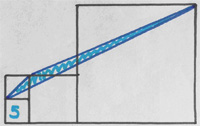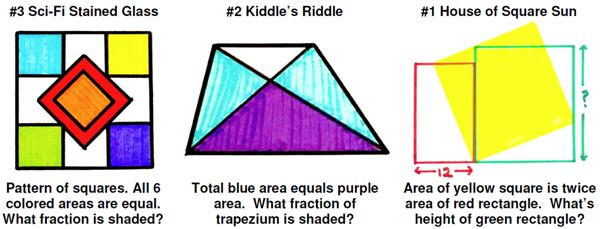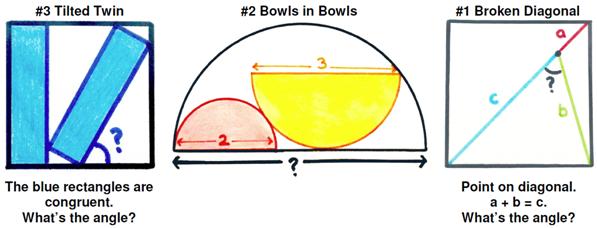 This is a collection of simple but elegant puzzles, mostly from a British high school math teacher Catriona Shearer, for which I thought I would show solutions (solutions for a number of them had not been posted yet on Twitter at the time of writing). See the Geometric Puzzle Medley.
This is a collection of simple but elegant puzzles, mostly from a British high school math teacher Catriona Shearer, for which I thought I would show solutions (solutions for a number of them had not been posted yet on Twitter at the time of writing). See the Geometric Puzzle Medley.
Apparently Catriona Shearer creates these problems herself, which shows an especially gifted talent. Ben Olin, of Math with Bad Drawings fame, had an interesting interview with Ms. Shearer. The reason for the interest in her work becomes evident the more of her geometry problems one sees. They are especially elegant and minimalist, and often have simple solutions, as exemplified by the “5 Problem” or “Shear Beauty” problem illustrated here. Words, such as “beauty” and “elegance”, are often bandied about concerning various mathematical subjects, but as with any discussion of esthetics, the efforts at explanation usually fall flat. Shearer’s problems are one of the best examples of these ideas I have ever seen. If you contemplate her problems and even solve them, you will understand the meaning of these descriptions.
One of the key aspects of mathematics is often its “hidden-ness” (some would say “opacity” or “incomprehension”). Her problems appear to have insufficient information to solve. But as you look at the usually regular figures, you see that there are inherent rigid constraints that soon yield specific information that leads to a solution. This discovery is akin to the sensation of discovering Newton’s mathematical laws underlying physical reality. It is the essence of one of the joys of mathematics.
Continue reading →


 I have been subverted again by a recent post by Ben Orlin, “
I have been subverted again by a recent post by Ben Orlin, “
 This is a collection of simple but elegant puzzles, mostly from a British high school math teacher
This is a collection of simple but elegant puzzles, mostly from a British high school math teacher